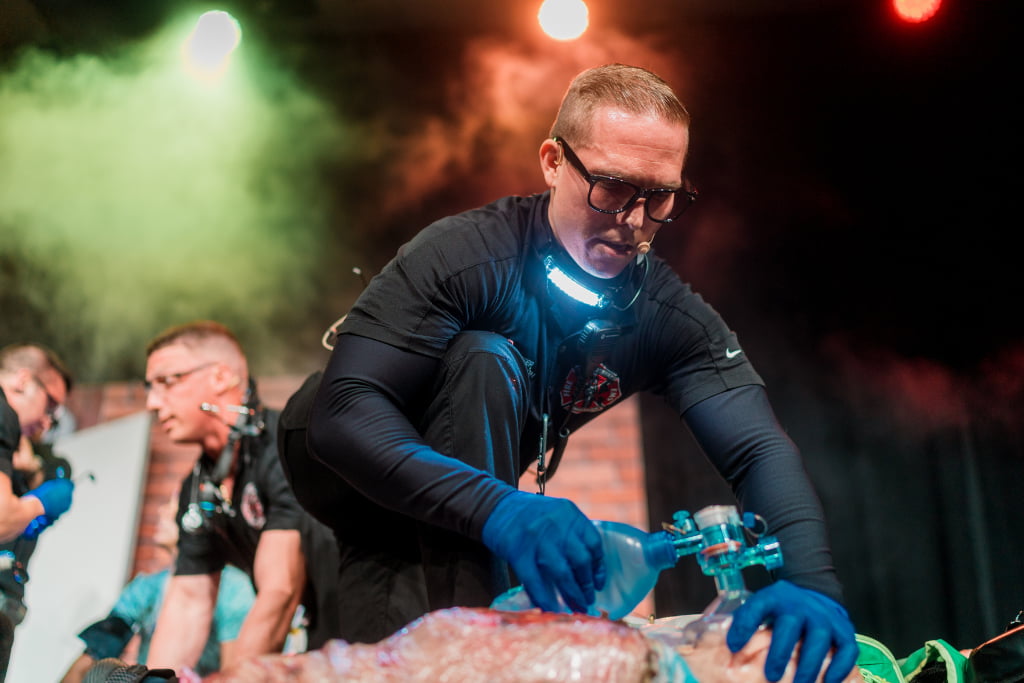
Manual ventilation is performed by a paramedic on a simulator. (Photo/Adam Mason)
On the go? Listen to the article in the player below!
Summary
Manual ventilation is a basic skill that every emergency medical services (EMS) responder is expected to perform proficiently. Improper manual ventilation may result in significant morbidity; however, there is no feedback mechanism or method of control for the volume, pressure, or frequency during manual ventilation. In this study, we aimed to quantify the ventilation parameters of manually delivered breaths using a simulated lung.
One-hundred ninety-nine volunteer EMS responders from the EMS World Expo 2019 and EMS Today 2020 participated in this study. Volunteers manually ventilated a simulated lung using a manual resuscitator bag for 18 breaths. Descriptive statistics were computed for peak pressures (Ppeak) and tidal volumes (VT)), and a multivariable linear regression was conducted to determine whether there was an independent correlation between Ppeak or VT and seven different variables (sex, using one versus two hands, hand length, hand width, self-confidence rating, frequency of manual resuscitator use per month, and years of experience).
Related: Vintage Manual Ventilation: The 1,500 mL BVM (Bag-Valve-Mask Manual Resuscitator)
Both Ppeak and VT delivered by EMS responders had a high level of variability. 83% of providers delivered at least one breath exceeding the recommended safety thresholds of 22 cm H2O Ppeak or 560 mL VT. In addition, 98% of first responders delivered at least one breath that was inadequate or excessive (VT <420 or >560 mL or Ppeak <10 or >22 cm H2O). Ppeak and VT were significantly higher in those using two hand manual ventilation (p < 0.001, effect size 114.96 mL, p < 0.001, effect size 8.92 cm H20).
Our study demonstrated large variability of VT and Ppeak within and, to a lesser degree, between providers. Our results showed no likely clinical significant role of gender, hand size, frequency of use or years of experience in determining Ppeak and VT. Out of the seven variables that might have affected tidal volume or peak pressures, only the use of two hands versus one hand had a potentially clinically significant effect. Our study identifies a clear need for evolving the manual resuscitator in order to ensure every provider can consistently deliver breaths at appropriate volumes and safe pressures.
University of Tennessee Health Science Center, Department of Emergency Medicine, Memphis, TN
University of Tennessee Health Science Center, UTHSC Department of Emergency Medicine, Memphis, TN
University of Tennessee Health Science Center, UTHSC Department of Emergency Medicine, Memphis, TN
Emergency Medicine
University of Tennessee Health Science Center, UTHSC Department of Emergency Medicine, Memphis, TN






OMG! This is alarming. We should replace AMBU bags with new ventilators.
It is really interesting how insidious under-ventilation is during manual ventilation. 40% is a large number. Our agency had switched to the smaller bags, but had to switch back to the large adult bags because of this problem.
I am very sure that many folks are not aware of this problem.
Brilliant work! Nothing unexpected though. We try to focus on complex interventions but lack basic skills of ambu bagging.
Good study. We must do better for our patients!
Thank you for conducting the in-depth study and sharing it with us. Very thorough. It is unfortunate that we are still in the 1990s with EMS airway.
On a funny note, I wasn’t aware there was a XXXL in hand size.